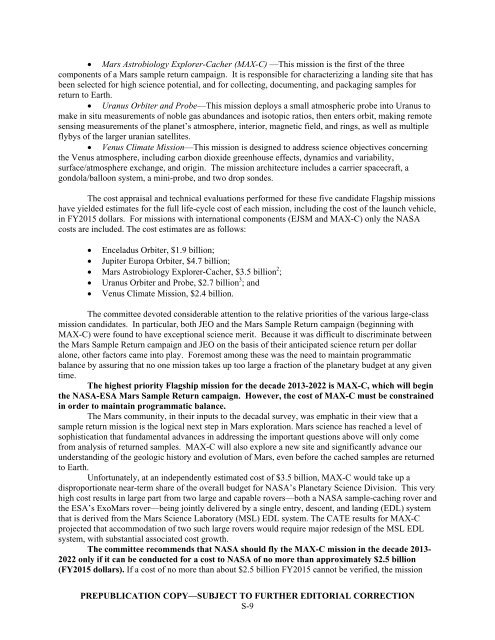Vision and Voyages for Planetary Science in the - Solar System ...
Vision and Voyages for Planetary Science in the - Solar System ...
Vision and Voyages for Planetary Science in the - Solar System ...
You also want an ePaper? Increase the reach of your titles
YUMPU automatically turns print PDFs into web optimized ePapers that Google loves.
• Mars Astrobiology Explorer-Cacher (MAX-C) —This mission is <strong>the</strong> first of <strong>the</strong> three<br />
components of a Mars sample return campaign. It is responsible <strong>for</strong> characteriz<strong>in</strong>g a l<strong>and</strong><strong>in</strong>g site that has<br />
been selected <strong>for</strong> high science potential, <strong>and</strong> <strong>for</strong> collect<strong>in</strong>g, document<strong>in</strong>g, <strong>and</strong> packag<strong>in</strong>g samples <strong>for</strong><br />
return to Earth.<br />
• Uranus Orbiter <strong>and</strong> Probe—This mission deploys a small atmospheric probe <strong>in</strong>to Uranus to<br />
make <strong>in</strong> situ measurements of noble gas abundances <strong>and</strong> isotopic ratios, <strong>the</strong>n enters orbit, mak<strong>in</strong>g remote<br />
sens<strong>in</strong>g measurements of <strong>the</strong> planet’s atmosphere, <strong>in</strong>terior, magnetic field, <strong>and</strong> r<strong>in</strong>gs, as well as multiple<br />
flybys of <strong>the</strong> larger uranian satellites.<br />
• Venus Climate Mission—This mission is designed to address science objectives concern<strong>in</strong>g<br />
<strong>the</strong> Venus atmosphere, <strong>in</strong>clud<strong>in</strong>g carbon dioxide greenhouse effects, dynamics <strong>and</strong> variability,<br />
surface/atmosphere exchange, <strong>and</strong> orig<strong>in</strong>. The mission architecture <strong>in</strong>cludes a carrier spacecraft, a<br />
gondola/balloon system, a m<strong>in</strong>i-probe, <strong>and</strong> two drop sondes.<br />
The cost appraisal <strong>and</strong> technical evaluations per<strong>for</strong>med <strong>for</strong> <strong>the</strong>se five c<strong>and</strong>idate Flagship missions<br />
have yielded estimates <strong>for</strong> <strong>the</strong> full life-cycle cost of each mission, <strong>in</strong>clud<strong>in</strong>g <strong>the</strong> cost of <strong>the</strong> launch vehicle,<br />
<strong>in</strong> FY2015 dollars. For missions with <strong>in</strong>ternational components (EJSM <strong>and</strong> MAX-C) only <strong>the</strong> NASA<br />
costs are <strong>in</strong>cluded. The cost estimates are as follows:<br />
• Enceladus Orbiter, $1.9 billion;<br />
• Jupiter Europa Orbiter, $4.7 billion;<br />
• Mars Astrobiology Explorer-Cacher, $3.5 billion 2 ;<br />
• Uranus Orbiter <strong>and</strong> Probe, $2.7 billion 3 ; <strong>and</strong><br />
• Venus Climate Mission, $2.4 billion.<br />
The committee devoted considerable attention to <strong>the</strong> relative priorities of <strong>the</strong> various large-class<br />
mission c<strong>and</strong>idates. In particular, both JEO <strong>and</strong> <strong>the</strong> Mars Sample Return campaign (beg<strong>in</strong>n<strong>in</strong>g with<br />
MAX-C) were found to have exceptional science merit. Because it was difficult to discrim<strong>in</strong>ate between<br />
<strong>the</strong> Mars Sample Return campaign <strong>and</strong> JEO on <strong>the</strong> basis of <strong>the</strong>ir anticipated science return per dollar<br />
alone, o<strong>the</strong>r factors came <strong>in</strong>to play. Foremost among <strong>the</strong>se was <strong>the</strong> need to ma<strong>in</strong>ta<strong>in</strong> programmatic<br />
balance by assur<strong>in</strong>g that no one mission takes up too large a fraction of <strong>the</strong> planetary budget at any given<br />
time.<br />
The highest priority Flagship mission <strong>for</strong> <strong>the</strong> decade 2013-2022 is MAX-C, which will beg<strong>in</strong><br />
<strong>the</strong> NASA-ESA Mars Sample Return campaign. However, <strong>the</strong> cost of MAX-C must be constra<strong>in</strong>ed<br />
<strong>in</strong> order to ma<strong>in</strong>ta<strong>in</strong> programmatic balance.<br />
The Mars community, <strong>in</strong> <strong>the</strong>ir <strong>in</strong>puts to <strong>the</strong> decadal survey, was emphatic <strong>in</strong> <strong>the</strong>ir view that a<br />
sample return mission is <strong>the</strong> logical next step <strong>in</strong> Mars exploration. Mars science has reached a level of<br />
sophistication that fundamental advances <strong>in</strong> address<strong>in</strong>g <strong>the</strong> important questions above will only come<br />
from analysis of returned samples. MAX-C will also explore a new site <strong>and</strong> significantly advance our<br />
underst<strong>and</strong><strong>in</strong>g of <strong>the</strong> geologic history <strong>and</strong> evolution of Mars, even be<strong>for</strong>e <strong>the</strong> cached samples are returned<br />
to Earth.<br />
Un<strong>for</strong>tunately, at an <strong>in</strong>dependently estimated cost of $3.5 billion, MAX-C would take up a<br />
disproportionate near-term share of <strong>the</strong> overall budget <strong>for</strong> NASA’s <strong>Planetary</strong> <strong>Science</strong> Division. This very<br />
high cost results <strong>in</strong> large part from two large <strong>and</strong> capable rovers—both a NASA sample-cach<strong>in</strong>g rover <strong>and</strong><br />
<strong>the</strong> ESA’s ExoMars rover—be<strong>in</strong>g jo<strong>in</strong>tly delivered by a s<strong>in</strong>gle entry, descent, <strong>and</strong> l<strong>and</strong><strong>in</strong>g (EDL) system<br />
that is derived from <strong>the</strong> Mars <strong>Science</strong> Laboratory (MSL) EDL system. The CATE results <strong>for</strong> MAX-C<br />
projected that accommodation of two such large rovers would require major redesign of <strong>the</strong> MSL EDL<br />
system, with substantial associated cost growth.<br />
The committee recommends that NASA should fly <strong>the</strong> MAX-C mission <strong>in</strong> <strong>the</strong> decade 2013-<br />
2022 only if it can be conducted <strong>for</strong> a cost to NASA of no more than approximately $2.5 billion<br />
(FY2015 dollars). If a cost of no more than about $2.5 billion FY2015 cannot be verified, <strong>the</strong> mission<br />
PREPUBLICATION COPY—SUBJECT TO FURTHER EDITORIAL CORRECTION<br />
S-9











